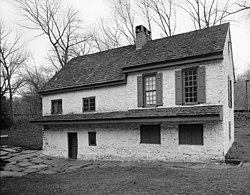Historic RittenhouseTown | |
 Rittenhouse homestead | |
| Location | 206–210 Lincoln Drive, Philadelphia, Pennsylvania |
|---|---|
| Coordinates | 40°01′43″N75°11′28″W / 40.02860°N 75.19112°W |
| Area | 84 acres (34 ha) |
| Built | 1690–1732 |
| Architectural style | Georgian, Federal |
| NRHP reference No. | 92001878 |
| Significant dates | |
| Added to NRHP | April 27, 1992 [1] |
| Designated NHLD | April 27, 1992 [2] |
| Designated PHMC | April 8, 1991 [3] |
Historic RittenhouseTown, sometimes referred to as Rittenhouse Historic District, encompasses the remains of an early industrial community which was the site of the first paper mill in British North America. The mill was built in 1690 by William Rittenhouse and his son Nicholas on the north bank of Paper Mill Run (Monoshone Creek) near (and now within) Philadelphia, Pennsylvania. The district, off Lincoln Drive near Wissahickon Avenue in Fairmount Park, includes six of up to forty-five original buildings. RittenhouseTown was listed on the National Register of Historic Places and was designated a National Historic Landmark District on April 27, 1992. [2] [4]



